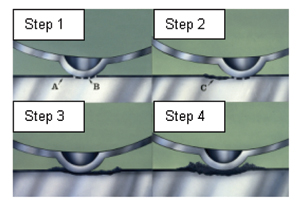If you work with automotive terminals, you may have heard folks talking about fretting corrosion. A lot of people know that fretting corrosion isn’t a good thing, but they aren’t sure exactly what it is. Hopefully, the following information will help explain what fretting corrosion is all about.
Some Definitions
“Fretting” is a term to describe a small amplitude rubbing motion between two surfaces. By definition, the amount of relative movement between the contacting surfaces is about 10 to 100 microns for fretting. To put this in perspective, a sheet of paper is about 100 microns thick, so fretting motion is pretty small and hard to see. Vibration and thermal expansion/contraction are the main sources that create fretting motion. Since cars vibrate and can experience some relatively large temperature swings, they are a good source for fretting motion.
Fretting and fretting wear can occur on non-electrical things like bearings, but fretting corrosion is something that is associated more with electrical contacts. Fretting corrosion is the name for a buildup of insulating, oxidized wear debris that can form when there is small amplitude fretting motion between electrical contacts. The oxidized wear debris can pile up enough at the electrical contact spots that the electrical resistance across the connection increases a lot. The drawing here shows a magnified, cross-sectional view of the fretting corrosion sequence on a tin-plated terminal contact interface.

Step 1 shows how the thin tin-oxide layer, cracks under pressure when the contact is first made. The tin-oxide layer is represented as a thin black line (A). Nice, clean tin (B) oozes though the cracks in the tin-oxide layer, making a very stable electrical connection. If the contact spot moves, a microscopic amount from fretting motion (as shown in Step 2), the clean tin is exposed to the air and it quickly forms an insulating tin-oxide film (C). Every time there is motion at the contact spot, the cycle repeats and more tin-oxide wear debris builds up, as shown in Step 3. With continued microscopic fretting movement between contacting surfaces, enough insulating tin-oxide wear debris can build up that high resistance and or intermittent connections can develop, as shown in Step 4.
Tin plating was used for the example above. However, copper, nickel, iron, zinc and other metals that form oxides are also susceptible to fretting corrosion.
So, What’s The Big Deal About Fretting Corrosion?
Fretting corrosion problems are really annoying and they can be very expensive to fix. That’s why it’s a big deal and we do whatever we can to prevent it from
occurring on our connection systems.
On low current, signal circuits, fretting corrosion can cause intermittent connections. An intermittent connection is when the signal disappears temporarily for maybe a microsecond or a millisecond, and then everything starts working normally again. An intermittent connection on a signal circuit can cause the electronics in a car to get all confused, so the car doesn’t run right. Intermittent connections are really hard to find, since they can have low resistance and they can look like new most of the time. About the only way to actually find an intermittent connection is to have a vehicle hooked up to a lot of special instrumentation while it is having troubles. More commonly, technicians will replace sensors and computers until the problem goes away.
This can get very expensive and it can take forever.
On high current, power circuits, intermittent connections should not degrade performance, however, relatively small, permanent increases in the connection resistance can lead to overheating. For example, a connector with a 20-amp circuit can melt and develop an open circuit if the connection resistance increases by only a few milliohms. Fretting corrosion can easily increase the connection resistance by this amount.
What Does Fretting Corrosion Look Like?
There is nothing very exciting about the appearance of fretting corrosion. Severe cases look like little, dark smudges on electrical terminals. The smudges appear at the locations where the actual electrical contact is made. In less severe cases, fretting corrosion is hard to see, so we have to use some special laboratory equipment to identify it.
How Can We Prevent Fretting Corrosion?
Delphi terminals and connectors are designed to resist fretting corrosion, but here are some general pointers for additional fretting corrosion protection.
1. Minimize relative movement between terminals.
• Extra clamps or brackets can reduce connector movement.
• Terminals with high contact force usually resist fretting
corrosion better than low contact force terminals.
• Connector designs that allow
terminals to “float” are resistant to fretting corrosion caused by
thermal cycling.
2. Use terminal contact materials that are not susceptible to fretting corrosion.
• Gold or silver-based terminal contact coatings resist fretting corrosion better than tin plating.
3. Use contact lubricants.
• Specialized contact lubricants can help delay the onset of
fretting corrosion.
Courtesy of Delphi.












